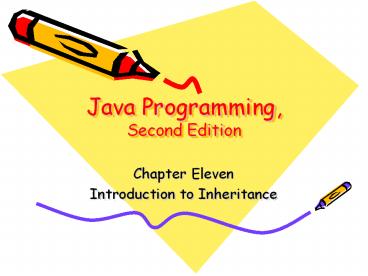Java Programming, Second Edition - PowerPoint PPT Presentation
Title:
Java Programming, Second Edition
Description:
Java Programming, Second Edition Chapter Eleven Introduction to Inheritance In this chapter, you will: Learning about the Concept of Inheritance Inheritance ... – PowerPoint PPT presentation
Number of Views:116
Avg rating:3.0/5.0
Title: Java Programming, Second Edition
1
Java Programming, Second Edition
- Chapter Eleven
- Introduction to Inheritance
2
In this chapter, you will
- Learn about the concept of inheritance
- Extend classes
- Override superclass methods
- Work with superclasses that have constructors
- Use superclass constructors that require
arguments - Access superclass methods
- Learn about information hiding
- Use methods you cannot override
3
Learning about the Concept of Inheritance
- Inheritance- Mechanism that enables one class to
inherit both the behavior and the attributes of
another class - The classes you create can inherit data and
methods from existing classes - You can apply your knowledge of a general
category to a more specific category
4
Inheritance Advantages
- When you use inheritance you
- Save time
- Reduce errors
- Ease understanding
5
Inheritance Terms
- Base class a class that is used as a basis for
inheritance - Superclass
- Parent class
- Derived class- a class that inherits from a base
class - Subclass
- Child class
6
(No Transcript)
7
Extending classes
- Use the keyword extends to achieve inheritance
within the Java programming language - public class EmployeeWithTerritory extends
Employee - Creates a superclass-subclass relationship
between Employee and EmployeeWithTerritory
8
(No Transcript)
9
Overriding Superclass Methods
- Polymorphism- Using the same method name to
indicate different implementations - Means many forms
- Each child class method overrides the method that
has the same name in the parent class
10
Working with Superclasses that Have Constructors
- When you create any subclass object, the
superclass constructor must execute first, and
then the subclass constructor executes - When you instantiate an object that is a member
of a subclass, you are actually calling at least
two constructors - the constructor for the base class
- the constructor for the extended, derived class
11
Using Superclass Constructors that Require
Arguments
- When you create a class and do not provide a
constructor, Java automatically supplies you with
one that never requires arguments - When you write your own constructor, you replace
the automatically supplied version - The constructor you create for a class might
require arguments
12
Using Superclass Constructors that Require
Arguments
- When a superclass requires arguments, you must
include a constructor for each subclass - Your subclass constructor can contain any number
of statements, but the first statement must call
the superclass constructor - super(list of arguments)
- Keyword super always refers to the superclass of
the class in which you use it
13
Accessing Superclass Methods
- You might want to use the superclass method
within a subclass - You can use the keyword super to access the
parent class method
14
Information Hiding
- Information Hiding- The concept of keeping data
private - When you employ information hiding, your data can
be altered only by the methods you choose and
only in ways that you control - Private members of the parent class are not
inherited - When a program is a class user, it cannot
directly alter any private field
15
Protected
- Protected- Provides you with an intermediate
level of security between public and private
access - If you create a protected data field or method,
it can be used within its own class or in any
classes extended from that class, but it cannot
be used by outside classes
16
Methods You Cannot Override
- There are four types of methods that you cannot
override in a subclass - private methods
- static methods
- final methods
- Methods within final classes































